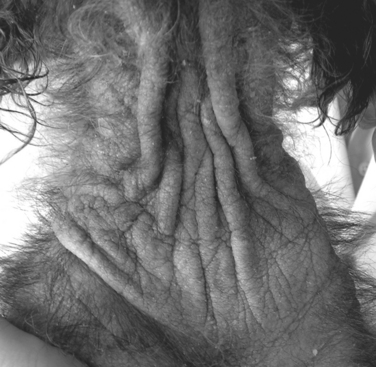M
Macadamia Nut Toxicosis
BASIC INFORMATION 
DEFINITION
Acute and often self-limiting toxicosis of dogs resulting from ingestion of macadamia nuts. It is characterized by paresis, depression, vomiting, ataxia, tremors, hyperthermia, abdominal pain, lameness, and/or stiffness. Toxicosis can occur after ingestion of commercially available macadamia nuts or macadamia nut-containing cookies or candies.
CLINICAL PRESENTATION
DIAGNOSIS 
DIFFERENTIAL DIAGNOSIS
TREATMENT 
ACUTE GENERAL TREATMENT
PEARLS & CONSIDERATIONS 
COMMENTS
Malassezia Dermatitis ![]()
BASIC INFORMATION 
EPIDEMIOLOGY
SPECIES, AGE, SEX: Very common in dogs of all ages; uncommon in cats of any age; either sex
RISK FACTORS
CLINICAL PRESENTATION
DISEASE FORMS/SUBTYPES
PHYSICAL EXAM FINDINGS
 MALASSEZIA DERMATITIS Malassezia dermatitis in a miniature poodle. Alopecia, erythema, and lichenification on the ventral neck.
MALASSEZIA DERMATITIS Malassezia dermatitis in a miniature poodle. Alopecia, erythema, and lichenification on the ventral neck.(Copyright Dr. Manon Paradis.)
DIAGNOSIS 
INITIAL DATABASE
ADVANCED OR CONFIRMATORY TESTING
TREATMENT 
ACUTE GENERAL TREATMENT
CHRONIC TREATMENT
DRUG INTERACTIONS
Azole therapy may alter the metabolism or distribution of other prescribed medication by inhibiting cytochrome P450 metabolizing enzymes and P-glycoprotein transporting pumps. Terbinafine does not inhibit these enzymes. Specifically, azoles cannot be given with macrocyclic lactones (e.g., avermectins); if so, dosage reduction and close monitoring is required (see p. 706).
POSSIBLE COMPLICATIONS
PROGNOSIS AND OUTCOME 
PEARLS & CONSIDERATIONS 
COMMENTS
Åhman S, Perrins N, Bond R. Treatment of Malassezia pachydermatts-associated seborrheic dermatitis in Devon Rex cats with itraconazole-a pilot study. Vet Dermatol. 2007;18:171-174.
Chen TA, Hill PB. The biology of Malassezia organisms and their ability to induce immune responses and skin disease. Vet Dermatol. 2005;16:4-26.
Negre A, Bensignor E, Guillot J. Evidence-based veterinary dermatology: a systematic review of interventions for Malassezia dermatitis in dogs. Vet Dermatol. 2008;20:1-12.
Malignant Fibrous Histiocytoma
BASIC INFORMATION
DEFINITION
An uncommon primary tumor made up of fibrous and inflammatory cells thought to arise from a primitive mesenchymal cell. It is not to be confused with malignant histiocytosis (histiocytic sarcoma), a disease of localized or multisystemic histiocytic infiltration (see p. 535).
EPIDEMIOLOGY
SPECIES, AGE, SEX: Malignant fibrous histiocytoma is an uncommon tumor of the skin and subcutaneous tissue of dogs and cats, and can also occur in the spleen in dogs. This tumor type has been reported at injection sites in cats (see p. 610).
GENETICS & BREED PREDISPOSITION: Golden retrievers and rottweilers may be overrepresented.
CLINICAL PRESENTATION
DISEASE FORMS/SUBTYPES
HISTORY, CHIEF COMPLAINT
ETIOLOGY AND PATHOPHYSIOLOGY
DIAGNOSIS
INITIAL DATABASE
ADVANCED OR CONFIRMATORY TESTING
TREATMENT
ACUTE AND CHRONIC TREATMENT
POSSIBLE COMPLICATIONS
Complications of treatment depend on types of treatments and location of the primary tumor.
PROGNOSIS AND OUTCOME 
PEARLS & CONSIDERATIONS 
COMMENTS
Aside from the giant-cell variant, malignant fibrous histiocytoma should be considered like other soft tissue sarcomas (see p. 1034) in treatment and prognosis. Tumors at injection sites in cats should be treated like injection-site sarcomas (see p. 610).
Malnutrition
BASIC INFORMATION 
EPIDEMIOLOGY
SPECIES, AGE, SEX: Malnutrition can affect animals of any species, age, life stage, or lifestyle.
RISK FACTORS
CLINICAL PRESENTATION
ETIOLOGY AND PATHOPHYSIOLOGY
DIAGNOSIS 
INITIAL DATABASE
TREATMENT 
ACUTE GENERAL TREATMENT
CHRONIC TREATMENT
PROGNOSIS AND OUTCOME 
PEARLS & CONSIDERATIONS 
COMMENTS
PREVENTION
TECHNICIAN TIPS
Abood S, McLoughlin M, Buffington T. Enteral nutrition. In: DiBartola SP, editor. Fluid, electrolyte, and acid–base disorders small animal practice. ed 3. St Louis: Saunders Elsevier; 2006:601-620.
Buffington T, Holloway C, Abood S. Manual of veterinary dietetics. St Louis: Elsevier, 2004.
Chan DL. Nutritional requirements of the critically ill patient. Clin Tech Small Animal Pract. 2004;19:1-5.
Eirmann L, Michel K. Enteral Nutrition. In: Silverstein D, Hopper K, editors. Small animal critical care medicine. St Louis: Saunders, 2009.
Freeman L, Chan D. Total parenteral nutrition. In: DiBartola SP, editor. Fluid, electrolyte, and acid–base disorders small animal practice. ed 3. St Louis: Saunders Elsevier; 2006:548-600.
Remillard RL, Armstrong PJ, Davenport DJ. Assisted feeding in hospitalized patients: enteral and parenteral nutrition. In Hand MS, Thatcher CD, Remillard RL, Roudebush PR, editors: Small animal clinical nutrition, ed 4, Topeka: Mark Morris Institute, 2000.



